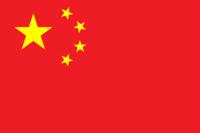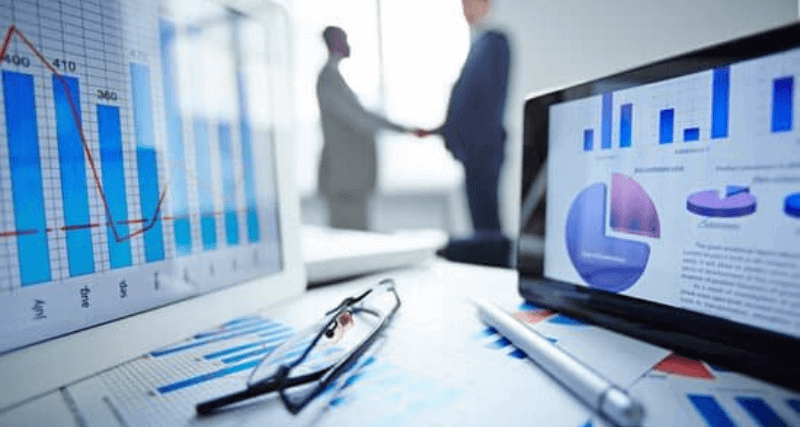
Given that we are trading currency pairs that display the relative strength of one currency against another, we must seek to compare the economic forces behind each currency within the pair. For instance, if we are looking at interest rates, we must look at the difference in interest rates, called interest rate differential, between the two pairs, not just the interest rate of the one.
Moreover, every fundamental force comparison must look at the present and past conditions, and speculate upon the short and long term future prospects. Learn how to read fundamental analysis in Forex and discover in this article the top 10 market forces that drive the currency markets and influence price.
Below are the top 10 fundamental forces that drive the currency markets.
Table of Contents
Interest Rates
Central banks enact their monetary policy by controlling overnight or short-term interest rates. They use these rates to lend money to commercial banks to influence mortgage rates and other types of loans. The monetary policy of a central bank will aim at controlling inflation and/or promoting economic growth. For instance, the European Central bank (ECB) aims at keeping inflation under 2% while the U.S. Federal Reserve has a dual mandate to promote economic growth and maintain price stability.
Impact on forex and economy
Interest rates and the monetary policy that sets them have a profound effect on a currency’s relative value and on domestic economic activity. Interest rates influence currencies directly in attracting investors to the higher interest-bearing currencies and bonds, causing the higher interest currency to go up, or scaring away such investors with lower interest-bearing currencies and bonds, causing the low-interest currency to go down. Moreover, domestic interest rates influence overall economic activity, with the lower rates typically (and sometimes only theoretically) stimulating borrowing, investment, and consumption, while higher interest rates tend to reduce borrowing and increase saving over consumption. In addition, because lower rates push down the currency price, it makes exports cheaper for foreign consumers, which in turn helps the balance of trade.
For traders, the rule of thumb is:
| Interest Rate | Currency Effect | Inflation Effect | Growth Effect |
|---|---|---|---|
| Higher Rate | Strengthens Currency | Stabilizes Inflation | Slows Growth |
| Lower Rate | Weakens Currency | Increases Inflation | Stimulates Growth |
The difference in interest rates between one country and another is known as the interest rate differential, and investors will generally be attracted to the currency pair that exhibits a positive interest rate differential. For more on this see our article on the Carry Trade.
Comparison of Current And Historical Interest Rates:
One should first try to eyeball the current differences in interest rates within each pair, paying particular attention to the pairs that exhibit the greatest positive interest rate differential. For instance, below is a ranking of the major country’s interest rates, courtesy of tradingeconomics.com:
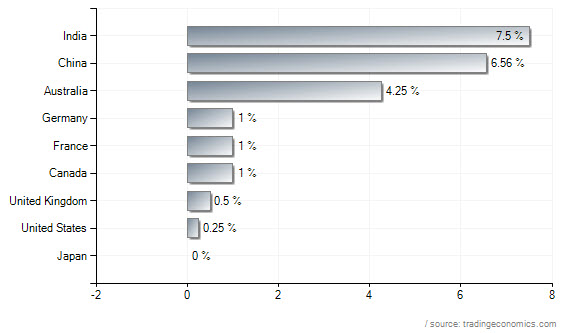
From the chart above one can immediately see that there is a big gap between the 4% positive interest rate differential between Australia’s 4.25% and United States’s 0.25%, suggesting that going long the AUD/USD (and picking up 4% per annum) would be the best carry trade.
Next one should drill down into the historical interest rates, preferably in overlayed chart format, to see the context of how the two country’s interest rates have changed relative to each other over time. Again, tradingeconomics.com shows a chart of an overlay of AUD interest rates set against USD interest rates with the AUDUSD exchange rate in the background:
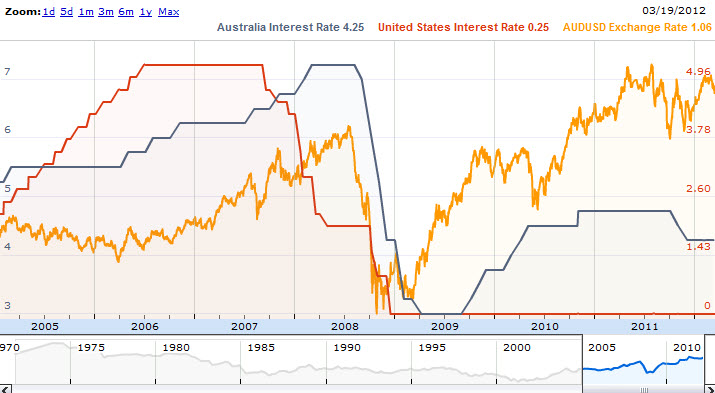
One can see from the above chart that the two rates fell dramatically in 2008, with USD falling from 5% to near zero and AUD falling from 7.25 to 3. It was not till Oct-2009 that you can see that AUD was climbing back out of its own bottom while the USD remained in the basement, signalling then to investors, that was the time to take the long carry trade on AUDUSD.
Economic Calendar: Central Bank Interest Rate Decisions and Speeches
Interest Rate Decisions
Impact: High
Countries: All
Frequency: Varies
The most significant event regarding interest rates in the economic calendar is the Central Bank Interest Rate Decisions. Here the central bank policy board makers come to a consensus on where to set the rate. Traders look closely for a difference in the forecast and actual rate, driving the domestic currency up on a higher than expected rate and driving it down on a lower than expected rate.
| Difference between forecast and actual | Currency Effect | Reason |
|---|---|---|
| Higher than forecast rate | Positive/bullish for currency | Foreign investors now want to own a higher interest-bearing currency (and bonds) |
| Lower than forecast rate | Negative/bearish for currency | Foreign investors are now less inclined to invest in a lower interest-bearing currency (and bonds) |
Central Banker Speeches
Impact: High
Countries: All
Frequency: Varies
From time to time, a central bank chairman or president may give a public speech to drop hints as to future monetary policy. He may voice concern about raising inflation, provoking speculation that he might raise interest rates to curb the inflation, or he may voice concern about the state of the economy and raising unemployment, provoking speculation that he might lower interest rates to stimulate borrowing and investment into the economy. Comments may thus determine a short term positive or negative trend. Be careful, however, as the volatility resulting from the interpretation of statements can be dangerous to short term trend traders.
Other forces that bear upon Interest Rate Decisions:
Inflation – higher percentage changes can prompt central bankers to increase interest rates to curb inflation
Current Account and Balance of Trade – lower numbers can prompt some central bankers to lower interest rates in order to deflate currency and increase exports
Unemployment – higher unemployment numbers can prompt central bankers to lower interest rates to spur investment and employment.
Inflation Rates
The erosion of the purchasing power of money is called inflation. With the advent of paper currencies, and the power of central banks to lower interest rates and print at will to increase the money supply, paper currencies as a form of money are always going to burn or erode in value. The result is long term inflation, irrespective of the short term supply/demand forces on the different goods and services within a country’s Consumer Price Index (CPI), the popular measure of inflation.
However, different currencies burn at different rates of speed, depending on the level of each country’s (or central bank’s) active manipulation of interest rates and printing presses, and we as traders are interested in the different burn rates. We are particularly interested in the rate of erosion of the purchasing power of the one currency against the other that make up the pair.
Impact on Forex and Economy
Higher inflation rates in an economy decrease demand for the investments (and currency denominated in them) because all or part of any expected asset yields can be erased by the level of inflation. For instance, an investor would be foolish to invest in a 5% per year bond yield of a country that is undergoing 6% inflation as he would be losing 1% per year. Central banks keep watch on the consumer price index to see if the inflation remains in acceptable standards or is going up too much. They will potentially increase the interest rate if they fear that the inflation rate has moved above acceptable levels. More often they will decrease the interest rate (or print money) when they see that inflation levels are modest and the economy is in the doldrums. In addition, governments use the CPI to make inflation-adjusted payments to Social Security beneficiaries, government employees and retirees, and food-stamp recipients.
For traders, the rule of thumb is:
| Inflation Rate | Currency Effect (Long Term) | Currency Effect (Short Term) | Short Term Reason |
|---|---|---|---|
| Higher Rate | Weakens currency | Strengthens currency | Traders might use this surging inflation data from the perspective of a central banker so worried about it that he needs to raise interest rates to control it. Raising interest rates, in turn, strengthens the currency. |
| Lower Rate | Strengthens currency | Weakens currency | Traders might see this from the perspective of a central banker who now feels more free to lower interest rates or initiate new rounds of quantitative easing (money printing) in light of benign inflation data and a faltering economy. Lower interest rates or printing money, in turn, strengthens the currency. |
Ultimately, long term, a higher rate of inflation more quickly deflates the currency. That is obvious. What is not so obvious is that in the short-term (perhaps even for the day of the event release), a higher rate change in inflation can be positive for the currency. The reason for this is that traders will speculate that the central bank might raise interest rates to control inflation. Of course, they can be wrong, and in today’s globally shattered economy, central bankers see the flagging GDP and unemployment as more pressing concerns than inflation. What is more likely to happen is that, if there is a lower than expected inflation number, then it can give the central banker more freedom to lower interest rates, or if interest rates are already in the basement, to print more money, in order to add lighter fuel to a struggling economy.
Comparison of current and historical inflation Rates
One should first try to eyeball the current differences in inflation rates within each pair, paying particular attention to the pairs that exhibit the greatest inflation rate differences. For instance, below is a ranking of the major country’s inflation rates, courtesy of tradingeconomics.com:
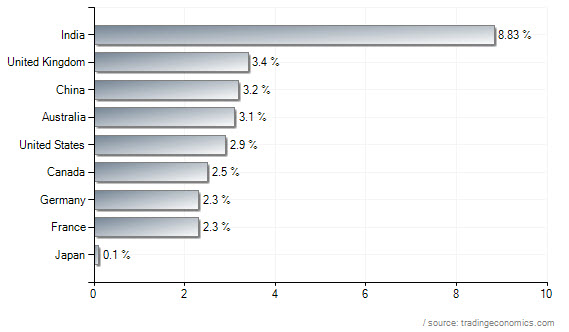
From the rankings chart above one can clearly see that the UK is major currency experiencing the greatest inflation rate of 3.4%, while Japan is experiencing the lowest at 0.1%, an inflation differential of 3.3%. What this means is that it becomes harder to justify being in a carry trade on GBPJPY when there is only a +0.5% positive interest rate differential that is more than completely erased by the -3.3% negative inflation rate differential.
Economic Calendar Events
Consumer Price Index (CPI)
Impact: Medium-High
Countries: US, UK, Japan, Switzerland, Eurozone, Leading European Countries
Frequency: Monthly
The most significant event regarding inflation rates in the economic calendar is the Consumer Price Index (CPI). The CPI is a price index which tracks the prices of a specified set of consumer goods and services, providing a measure of inflation. Different countries publish their own changes to the CPI, and traders look closely for a difference in forecast and actual rate for a short term trading opportunity, driving the domestic currency up on a higher than expected rate and driving it down on a lower than expected rate.
Core CPI
Impact: Medium-High
Countries: US, Canada, Eurozone
Frequency: Monthly
This report measures the change in the price of goods and services purchased by consumers, excluding food, energy, alcohol, and tobacco. Since the central bankers of US and Canada will focus on Core CPI (CPI minus food and energy prices) over CPI, traders will look more closely at Core CPI for inflation changes on USD or CAD.
Producer Price Index (PPI)
Impact: Medium
Countries: US, UK, Canada, Australia, Eurozone, Leading European Countries
Frequency: Monthly
The PPI measures changes in prices in goods sold by manufacturers (PPI Output), considered of low importance, and the prices of good and raw materials purchased by manufacturers (PPI Input), considered of medium importance. Since producers pass down higher costs to consumers, it can be a valuable early indicator of inflation and thus it shares the same short term and long term interpretation as the CPI.
| Difference between forecast and actual | Currency Effect | Possible Trigger Level | Potential Pip Range | Reason |
|---|---|---|---|---|
| CPI or PPI Higher than forecast rate | Positive/bullish for currency | +0.20% | 50 pips | Central bankers might see the higher inflation rate as a threat that needs to be subdued by a higher interest rate |
| CPI or PPI Lower than forecast rate | Negative/bearish for currency | -0.20% | 50 pips | Central bankers might see the lower inflation rate as a non-threat and so they can focus instead on keeping interest rates the same or lower. |
Note that an increase in inflation has a negative impact on any currency. It is thus very ironic that traders will trade up a currency due to it having a higher than forecast rate. They are only doing so because they are seeing the rate change from the eyes of the central banker, who might be threatened enough by the higher inflation to increase the interest rate in an attempt to curb it, and this increase in interest rate (if it happens) will in turn increase the demand for the currency.
Lately, as in the last 10 years, central bankers have been more concerned with lowering interest rates to fuel their flagging economies than the steadily upward (and under-reported) inflation rates that have internally eroded the purchasing power of most paper currencies. It could be argued that in the big picture, the higher CPI and PPI numbers are dangerous to the currency. The smart investors do not want to invest in a currency that is more rapidly devaluing (as seen from the CPI) and manufacturers do not want to set up plants in a country where the costs of production are higher (as seen from the PPI). One of the reasons that the Yen has been strengthening these last few years (along with Gold) is that its relatively “inflation-free environment” has been seen as a safe harbor for investors fearful about the inflationary burn rate of most other paper currencies.
Trade Balance and Current Account
Trade has evolved to become one of the most important forces shaping world economies, with the business of buying and selling products in foreign markets representing a significant percent of any large economy’s GDP. For instance, in the United States, more than 12 million jobs are tied to the exports sector, and about 25% of all U.S. business activity is linked in some fashion to international commerce. Usually, traders are interested in the “net export” figure. Exports represent a country’s competitiveness in world markets, its ability to create jobs and improve corporate profits. To satisfy domestic and foreign demand firms have to produce more and greater production translates into faster GDP growth. The downside of rising imports is that it subtracts from GDP growth since foreign companies make these products.
There are three key forces that shape a country’s trade balance: 1) relative difference in growth rates between the home country and others; 2) propensity for country’s consumers to shop for foreign goods; and 3) changing value of the home currency against other currencies. If the home country is growing faster than most other countries, imports will increase by a greater amount than exports, thus ensuring a deficit. However, some countries like the U.S. show an even greater propensity to import foreign goods than shoppers in other countries, which causes an additional problem for the US, which has been locked into annual trade deficits every year since 1976. Changes in currency values can alter the price of imports and exports and thus change demand. A stronger currency worsens the trade balance because it lowers the price of imports, making them more desirable for consumers, and at the same time, it raises the costs of goods sold in international markets, encouraging foreign buyers to look elsewhere for less expensive products.
Impact on Forex and Economy
The international trade in goods and services is a tangible way for a country to earn foreign exchange. A strong currency is built on exports exceeding imports. Net exports generate more revenue that stays in the country than goes out to purchase imports. Having more exports than imports translates into a healthy trade balance (and healthy current account) and leads to a more stable currency and economy. The more goods and services that foreigners buy from a country, the more of that country’s currency they will need to pay these products.
In contrast, a worsening trade deficit can undermine the currency. To purchase foreign goods and services, the country’s citizens must sell their currency to pay for the foreign products in their local currencies. Net imports (imports > exports) represent more money leaving the country than coming in, which leads to weaker exchange rates. It can also imply that local production of export goods has dropped and that the country has become a market for other countries to sell their products at the expense of our local industry, a situation which ultimately affects unemployment and wages and GDP. Moreover, sometimes a great appetite for consumption must be fueled by credit. To finance their huge consumption, the US has had to borrow, on average, more than 2 billion every day from foreigners, and this also weakens the dollar.
Economic Events
International Trade in Goods and Services (or Trade Balance):
Impact: High
Countries: Most
Frequency: Monthly
This report measures the difference in value between imported and exported goods and services over the reported period. A positive number indicates that more goods and services were exported than imported (more money received than spent), whereas a negative number indicates that more goods and services were imported than exported (more money spent than received).
Current Account Balance:
Impact: Medium
Countries: US, Canada, Australia, Japan, Eurozone
Frequency: Quarterly
It is the broadest accounting of a country’s trade and investment relationship with the rest of the world. One aspect of this report deals with the exchange of goods and services between the home country and others (see Balance of Trade above). But it is also broader than that. Besides selling and buying goods and services in foreign markets, there is also the import and export of investment capital. Every day foreigners buy and sell a country’s stocks, bonds, and other types of assets, and the return of investments abroad (dividends and interest payments) is income that flows back into the country. The quarterly report thus attempts to track all these cross border movements of goods and services, income flows from investments and purchases and sales of assets. The finance account shows the movement of investment capital and loans into and out of the country, including what foreign currency and securities the government owns and what other governments own of country’s currency.
Treasury International Capital System:
Impact: Medium
Countries: US
Frequency: Monthly
A report that tracks flows of investment funds entering and leaving the U.S. Since Americans love to shop beyond their means and the Federal government pays out more than collects, there exists a large gap between expenditures and income, which means that both households and the federal government have to borrow to fill the gap. Workers in Europe, Japan and China who are known to save from 5-40% of their income end up lending their excess savings to the US, purchasing US stocks, bonds and other dollar assets. This foreign lending becomes the capital the US needs to keep domestic interest rates low and economic growth to continue. Unfortunately, there will be a time when foreign creditors will find their portfolios heavily exposed to the US dollar, and they will begin to scale back and diversify into other currencies. In the economic calendar report, we will see a figure called the TIC Net Long-Term Transactions, which measures the difference in value between long-term foreign securities purchased by U.S. citizens and U.S. long-term securities purchased by foreign investors, expressed in billions. Demand for domestic securities and currency demand are directly linked because foreigners must buy the domestic currency to purchase the nation’s securities.
For traders, the rule of thumb is:
| Difference in Forecast and Actual: Current Account # or Trade Balance # | Currency Effect | Reason |
|---|---|---|
| Higher Trade Balance, Current Account Balance, and TIC Net Long Term Transactions, than forecast | Strengthens Currency | More money is coming in than going out (currency boost) and local export industry is looking more healthy (good for GDP). Any sign of a negative trade balance reversing course and begging to move closer to trade surplus is highly bullish. |
| Lower Trade Balance, Current Account, and TIC Net Long Term Transactions, than forecast | Weakens Currency | More money is leaving than staying (currency devaluation) and local export industry is looking less healthy (bad for GDP). Any sign of a negative trade balance getting progressively worse, or a positive trade balance reversing course, is bearish. |
Note: The reversal or narrowing of a negative trade balance can improve the currency only if it results from a greater international demand for the country’s goods and services. If the reversal or narrowing came about as a result of a deep recession, with import demand plummeting, investors would still shy away from the currency.
In the big picture, a positive balance of trade is known as a trade surplus and consists of exporting more than one imports (which means it has received more money than it has spent), whereas a negative balance of trade is known as a trade deficit and consists of importing more than one exports (more money being spent than received). Neither is inherently dangerous to large economies, but large trade deficits can be a sign of other economic problems. For instance, United States has been running a large trade deficit for a long time now, particularly with China, and China, in turn, reaps a blizzard of US dollar trade surpluses and reinvests it into US bonds. China’s trade strategy has been to gain as much global manufacturing share as possible, and it has accumulated a massive amount of forex reserves as a side effect of this strategy. To achieve this strategy, China has intentionally manipulated its currency, pegging it to the almost-always weaker US dollar, and as a result of this pegging and low labor and production costs, they have kept their exports cheap all over the world. These cheaper exports, in turn, have gutted American manufacturing jobs. European exporters have suffered more. With a weaker US dollar, US goods have been cheaper in Europe, but European goods have not been cheaper in either the US or China. With the US and Europe still in the clutches of the global recession, China will gain even more market share by keeping its currency peg and exporting its way to more growth.


